The Intel Broadwell Desktop Review: Core i7-5775C and Core i5-5675C Tested (Part 1)
by Ian Cutress on June 2, 2015 7:45 AM EST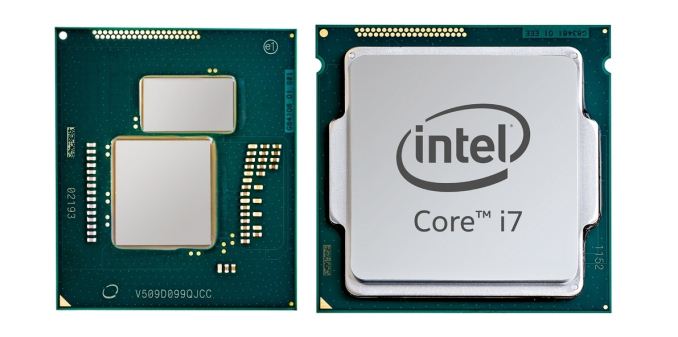
On almost all PC technology forums, it is hard to escape users talking about what Intel’s next processor lineup will be. Due to initial yield issues in Intel’s 14nm node, Broadwell in both mobile and desktop ended up being delayed, somewhat substantially in the case of the desktop. So while motherboard manufacturers released their Z97 platform over 6 months ago, we have been waiting for Broadwell to arrive. That day is today, and we can lay the smackdown with some benchmark numbers too.
The Road to Broadwell
Broadwell, in its top level explanation, is the 14nm die shrink of Haswell which was built on 22nm. Using Intel’s 14nm process this results in a smaller silicon die and lower power consumption. Frequency will depend on the architecture and if the process is suited to frequency or power, but the CPU core underneath is still more-or-less Haswell, with some minor tweaks of course.
As part of Intel’s tick-tock strategy, this would be considered a tick:
| Intel's Tick-Tock Cadence | |||||
| Microarchitecture | Process Node | Tick or Tock | Release Year | ||
| Conroe/Merom | 65nm | Tock | 2006 | ||
| Penryn | 45nm | Tick | 2007 | ||
| Nehalem | 45nm | Tock | 2008 | ||
| Westmere | 32nm | Tick | 2010 | ||
| Sandy Bridge | 32nm | Tock | 2011 | ||
| Ivy Bridge | 22nm | Tick | 2012 | ||
| Haswell | 22nm | Tock | 2013 | ||
| Broadwell | 14nm | Tick | Core-M: 2014 Others: 2015 |
||
If history tells us anything, ticks are usually accompanied by small IPC increases, resulting in 5-10% better performance depending on the benchmark, but ultimately ticks still follow the same capabilities of the processor before them. Intel usually uses its ticks to introduce a new chipset with a large number of capabilities, which we saw with Z97 and its use of M.2/SATA Express on the chipset. If the classical idea of a three year cycle between upgrades is true, then back in the summer of 2012, we were playing around with Ivy Bridge, the tick to Sandy Bridge.
The Broadwell Launch
Back in mid 2014, Intel launched Core M, the first 14nm processor in the mass market and the first Broadwell based product. Core M is the official marketing designation for what was historically the Y series processor (Broadwell-Y), but Core M played a different role to other Y series processors. Core M brought the Core architecture down to a 4.5W thermal design, enabling small and thin fanless 2-in-1 laptop/tablet designs. When the first products started appearing around Christmas and CES, we tested a few and even got down and dirty with the questions that OEMs had to answer with their own chassis designs.
At CES (January 2015), Intel launched Broadwell-U. These devices are aimed more at traditional laptops, mini-PCs and all-in-ones, with the lower-wattage SKUs targeting devices in the 15W range. At the same time higher power 28W SKUs were also announced, with the graphics gamut migrating through the basic Gen 8 package up to Crystal Well based Iris Pro, using onboard EDRAM as an additional cache to improve graphics performance.
After Y and U in Intel’s naming scheme typically comes H, representing higher power (47W-65W) mobile processors or ones suitable for all-in-one type desktop replacement devices which are, for the most part, stationary. H processors are favorites in business due to their high performance, but typically these devices also require large batteries and can come with large (15-17”) screens. They are all soldered down parts as well. Technically some of the H processors are part of the launch today.
After Y, U and H is somewhat of a miasma. The processor lineup, depending on who you speak to, might be DT, S, T, or K. Some of these are also used in the processor names themselves, but we will use Broadwell-DT for consistency. Normally an Intel desktop processor lineup spans a gamut of SKUs, from Celerons, Pentiums, i3, i5 and up to i7. Some ranges consist of 50 or so SKUs, whereby one segment (i5/i7, for example) are launched first and the rest are launched later.
That brings us to today. All-told, Intel is launching ten different SKUs, five 47W laptop and five 65W 'desktop', using a mix of socketed (LGA) and soldered (BGA) parts. All five desktop SKUs are still technically Broadwell-H, and all five are 65W quad-core models featuring Intel's Iris Pro integrated graphics and the product's associated Crystal Well L4 cache. Meanwhile in an interesting turn of events, the two socketed models will be breaking the mold by becoming the first H-family processors to be socketed. These will be the parts we're looking at today.
The Effect of TDP
If we move back to those large processor stacks, Intel tends to produce a range of products from 15W TDP (extreme low power Xeon) through 35W, 55W and up to 84-88W for consumer then 160W for Xeon. Sticking with the consumer line for the moment, the high end overclocking models have recently sat in that 84-88W bracket, donning the i5-K or i7-K moniker and being some of the most talked about processors on forums and for custom builds. Broadwell changes this, and a lot of users might not expect it to.
Because the top Broadwell-DT SKUs are based on Intel's Broadwell-H design, both of the these SKUs ship with a TDP of 65W. As a result, frequencies on the cores are lower, and it means that these processors are best suited for comparison to 65W Haswell processors, such as the i7-4790S or i5-4590S, rather than the i7-4770K or i7-4790K. Thus users looking to upgrade their i5-K or i7-K might be wondering where their 84W processor is.
But both Broadwell-DT processors are overclockable, which adds an element of intrigue. I’ll speak specifically about the Crystal Well implementation in a second, but whether having that extra eDRAM on board effect overclocking is going to be a poignant question moving forward. If a 4.6 GHz Haswell user can also achieve 4.6 GHz on Broadwell, then the benefit of any IPC increase along with the eDRAM might be a driver for purchase. Unfortunately althugh both of the socketed chips are unlocked, due to both time constraints and severe pre-release firmware issues, we're going to have to save overclocking on Broadwell-DT for Part 2 of our coverage.
Integrated Graphics
Intel announced several months ago that Broadwell would be getting the first socketed processor with a Crystal Well implementation that would also be overclockable. For a number of us in the industry, this piqued our interest substantially. Crystal Well, Intel’s name for CPUs that carry extra eDRAM, offers the potential to alleviate DRAM pressure by acting as an L4 cache, but also gives more memory bandwidth for integrated graphics. Given that integrated graphics are typically memory starved to begin with, Crystal Well when announced was an interesting prospect. Unfortunately, for Haswell based models, Intel limited the project to soldered processors only, which meant there was no possible direct desktop comparison. This changes with Broadwell-DT.
Aside from this, in terms of integrated graphics only usage, Broadwell-DT has a full GT3e configuration of execution units that a Broadwell processor has been announced to have. On Core-M we see 24 EUs, Atom x7 with 16, Pentium/Celeron Broadwell-U has 12, while there are various models with 23 or 24 EUs in the Broadwell-U i3/i5 and i7 lines and a few Broadwell-U models with the full 48 EUs with Iris Pro 6100. There will be some Broadwell-H models with 48, which is the number that Broadwell-DT models with the designation ‘C’ or ‘R’ will have.
The current king of the socketed integrated graphics world is AMD’s A10-7870K, which we recently reviewed. Broadwell-DT with Crystal Well is going after that crown.


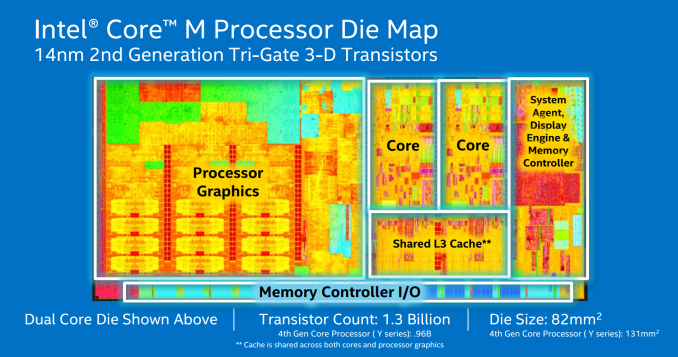
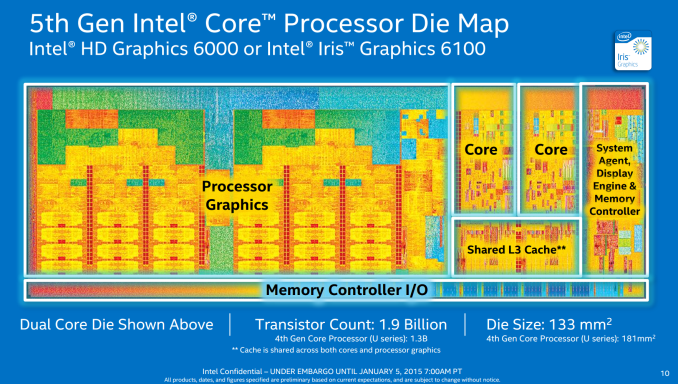
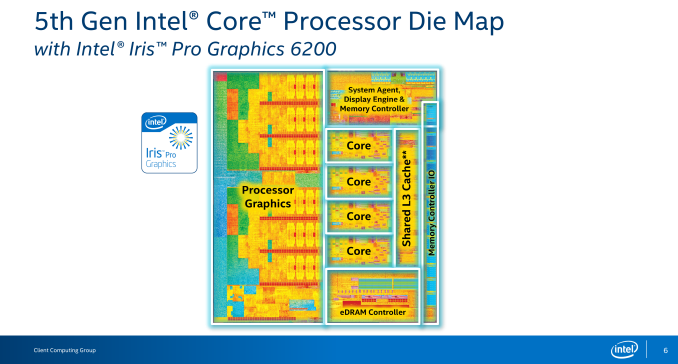
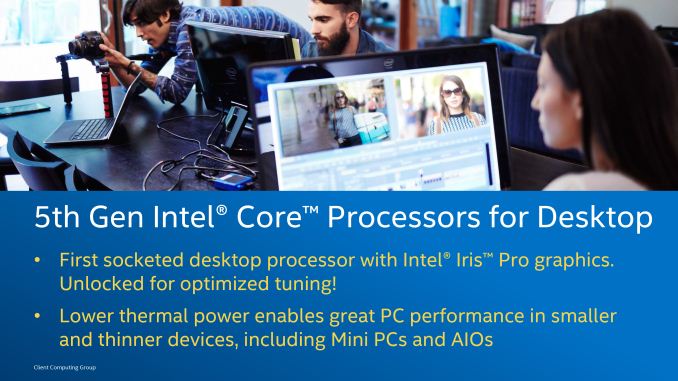
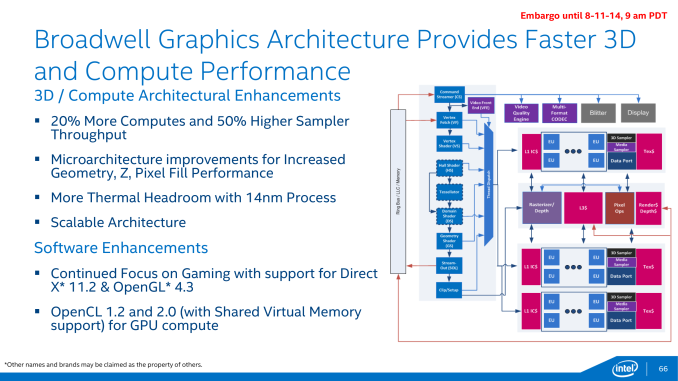








196 Comments
View All Comments
Jumangi - Tuesday, June 2, 2015 - link
Completely worthless release for gamers and PC enthusiasts...another year goes by with no reason to upgrade to a new CPU. Were officially back to the dark days before AMD kicked Intel in the nuts with the Athlon64 and made them have to compete.So sad...
Peichen - Tuesday, June 2, 2015 - link
Skylake is coming in 2 months for gamers. Today's release is for system builders that needs a stopgap. You shouldnt buy into AMD's PR campaign that you need to buy AMD to support innovation. Intel is doing that all by itself.PubFiction - Wednesday, July 1, 2015 - link
I agree 2500K and 2600K here haven't had a single reason to even be tempted to upgrade. The only good that has come of this is that now days I have gobs of cash to spend on GPUs, I guess this explains why NVidia can charge $999 for a GPU now and sell out.jjj - Tuesday, June 2, 2015 - link
Sad that Krzanich continues with this strategy of making products nobody needs and abusing their monopoly to charge way too much.Seriously, just 4 cores and a GPU that can't even do 1080p at those prices? Same die they could have fitted 12 cores and no GPU but we'll never get that because Intel has no interest in making good chips and regulators are all dead.
They'll choke on it, it's unavoidable.
TallestJon96 - Tuesday, June 2, 2015 - link
I only see this being good in all in ones and mini PCs. I fully expect Apple to announce a broadwell refresh for their iMacs before the year ends.Too bad, because I'm looking to upgrade from an i3-2120 to a low-ish power i5, and this fits the bill except that the integrated graphics drive the price through the roof. I'm hoping for a 65w vanilla i5 that performs well, and this is close, but not quite right.
MikhailT - Tuesday, June 2, 2015 - link
I somehow doubt it. They already refreshed the iMac a bit and dropped the prices for the year. They doesn't update as often as everyone else, they're happy to wait.I expect Apple to go full Skylake next year.
Peichen - Tuesday, June 2, 2015 - link
Well, AMD should pay or sue Intel to keep Intel from integrating GT3e GPU into sub $150 CPUs. That would kill all AMD's market above $80.MikhailT - Tuesday, June 2, 2015 - link
WTF, or how about AMD complete to make better stuff instead.Peichen - Tuesday, June 2, 2015 - link
AMD cannot compete. They are so far behind Intel on R&D and even vision and theories it has no chance of catching up to Intel any time soon. The CPU department is kept afloat by the GPU department and that isn't going well either.silverblue - Tuesday, June 2, 2015 - link
AMD doesn't have the money. The main reason it's behind the curve is because they couldn't exactly bring out something to replace Bulldozer and as such had to milk it for all it's worth so it wasn't a complete waste of time that could'v dragged them under. If AMD had the resources, I think we'd have seen a replacement for Bulldozer by now.AMD's GPU tech is hampered by the process node and the lack of eDRAM/HBM. Carrizo may make a large difference in terms of power consumption plus a lesser difference in terms of performance, but AMD stands to benefit a lot from throwing some memory on die. Coupled with better compression, they'll have a more competitive product, but I think Iris Pro 6200 has the leader for the next 12-18 months (even if Carrizo does come to the desktop, will its performance be that much improved over Kaveri? I'm not so sure).
I think we need high quality tests for the iGPUs to see how that makes a difference. Intel may lead by even more.